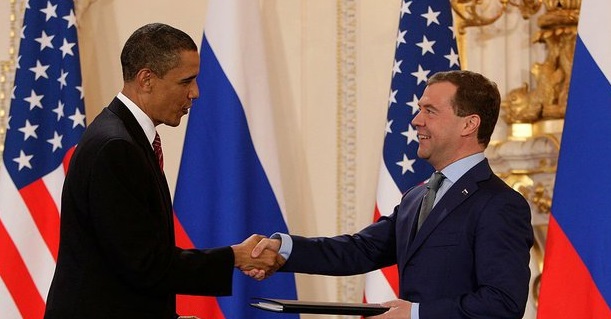New START to go?
February 9, 2019 | Expert Insights

Another U.S.-Russian nuclear pact is in danger following the U.S. move to withdraw from a Cold War-era arms control treaty, a senior Russian diplomat said. The Intermediate-Range Nuclear Forces Treaty between the US and Russia has already been scrapped by both countries.
Background
New START (Strategic Arms Reduction Treaty) (Russian: СНВ-III, SNV-III) is a nuclear arms reduction treaty between the United States and the Russian Federation with the formal name of Measures for the Further Reduction and Limitation of Strategic Offensive Arms. It was signed on 8 April 2010 in Prague, and, after ratification, entered into force on 5 February 2011. It was expected to last at least until 2021.
New START replaced the Treaty of Moscow (SORT), which was due to expire in December 2012. Its name is a follow-up to the START I treaty, which expired in December 2009, the proposed START II treaty, which never entered into force, and the START III treaty, for which negotiations were never concluded.
Under the terms of the treaty, the number of strategic nuclear missile launchers will be reduced by half. A new inspection and verification regime will be established, replacing the SORT mechanism. It does not limit the number of operationally inactive stockpiled nuclear warheads that remain in the high thousands in both the Russian and American inventories.
According to a Reuters report on February 9, 2017, in US President Donald Trump's first 60-minute telephone call with Russian President Vladimir Putin, Putin inquired about extending New START. President Trump attacked the treaty, claiming that it favoured Russia and was "one of several bad deals negotiated by the Obama administration".
Analysis
Deputy Foreign Minister Sergei Ryabkov charged that the U.S. refusal to negotiate an extension to the New Start treaty, signals Washington’s intention to let it expire in 2021. He warned that time is running out to save the pact, which was signed in 2010 by U.S. President Barack Obama and Russian President Dmitry Medvedev.
Ryabkov said that the U.S. has shown “no readiness or desire” to engage in substantive talks on extending the pact, which limits each country to no more than 1,550 deployed nuclear warheads and 700 deployed missiles and bombers.
U.S. Undersecretary of State Andrea Thompson argued in Wednesday’s phone call with reporters that there is enough time to discuss the treaty’s extension. “We have until 2021,” Thompson said. “It is a relatively simple treaty to extend, so we have time with that.”
However, Ryabkov warned that the procedure isn’t going to be simple. He noted that the U.S. said it has converted 56 Trident submarine-launched intercontinental ballistic missiles and 41 B-52H strategic bombers that carried nuclear weapons for use with conventional weapons, but stonewalled Russia’s repeated requests for a verifiable way to exclude their conversion back to nuclear status.
“In the worst-case scenario, they may carry 1,286 nuclear warheads,” he said, meaning that the U.S. could nearly double the number of deployed warheads allowed by the New START treaty. He said “that there is almost no time left” to discuss that and other issues for the treaty to be extended by another five years as envisaged during the signing.
Citing Russian violations, the U.S. on Saturday formally suspended its obligations under the INF that bans all land-based cruise and ballistic missiles with a range of 500 to 5,500 km (310 to 3,410 miles), setting the stage for the treaty to terminate in six months. Russia, which has denied any breaches, has followed suit.
Russian President Vladimir Putin instructed the military over the weekend to work on developing new land-based weapons that were previously forbidden by the INF treaty, but emphasized that such new weapons won’t be deployed to the European part of Russia or any other region unless the U.S. does so in those areas.
Ryabkov expressed particular worry about the U.S. plans to produce new, low-yield nuclear weapons, warning that it could dramatically lower the threshold for their use.
Assessment
Our assessment is that the mutual withdrawal from these treaties will leave the world closer to the threat of a nuclear war by provocation. We believe that the domestic political gains from this move are not as important as the security of the planet, particularly when the US and Russia account for more than 80% of all nuclear weapons.








Comments